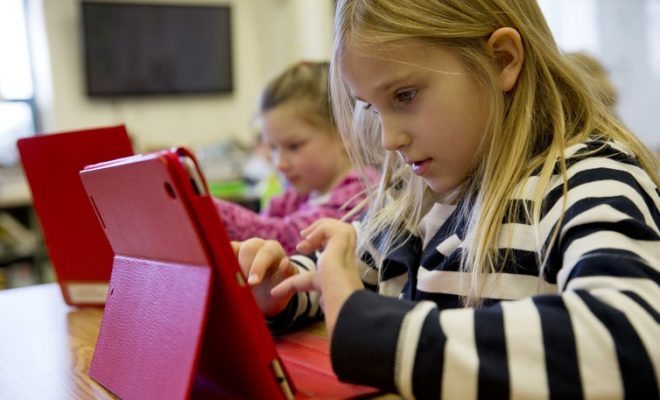Kids code their own 3D creations with new blocks-based design program


Adam Green, an instructor at Einstein’s Workshop, shows 3D printers to students learning BlocksCAD, a free 3D-design software developed at the Workshop. Photo: Chris Berdik
On a recent Saturday at Einstein’s Workshop, a maker space outside Boston, boisterous kids were busy with Legos, mini motors and gears, magnetic tiles, pipe cleaners, posterboard, markers and tape. In a side room, about a dozen elementary and middle school students were learning computer-aided design (CAD) for 3D printers. Their instructors shut the door, but couldn’t completely keep out the creative chaos. Nor did they want to.
Like all educators mixing high-tech with hands-on, they faced a familiar challenge—the freewheeling, playful problem-solving that comes naturally to kids using blocks or craft supplies isn’t easily replicated with a computer. A few years ago, when the folks at Einstein’s Workshop bought their first 3D printer, the available CAD software seemed either too technical for young kids or too simplistic, with limited flexibility for faster learners or more advanced students.
“Being a community of DIY hackers, we decided to make our own software,” said Solomon Menashi, BlocksCAD project manager. They wanted something as intuitive as Legos, but with the power and precision of real computer modeling. The result was BlocksCAD, a free Web-based program released in June 2015 that has spread to about 1,000 active users in schools, maker spaces and fab labs worldwide.
BlocksCAD benefits from students’ growing familiarity with block-based computer programming languages, starting with Scratch, developed about a decade ago at MIT. Millions of kids as young as kindergarten-age have used Scratch to learn the basics of coding and computational thinking, thanks to initiatives such as the Hour of Code. Another Scratch sibling popular with educators, called App Inventor, is used for programming mobile apps.
“When my students first opened up BlocksCAD, they said, oh, this is just like Hour of Code,” said Courtney Bedzyk, one of three middle-school science teachers in Hudson, Ohio, whose students used BlocksCAD this spring to design amusement park rides for a unit on electricity, magnetism, gravity and force diagrams. For Bedzyk, combining the exposure to 3D printing with computer programming is an educational twofer.
“It’s so relevant as far as where our society is going. And it makes them work their brains in new ways,” she said. “With some of my lowest performing students, this was the first time I’ve seen that spark of engagement and motivation in their eyes all year.”
According to Jennie Yoder, an instructor and the lead software developer at Einstein’s Workshop, the goal was to have one CAD program that could grow with the skills of each student, typically starting around third grade, when kids have a grasp of basic math and measuring in three dimensions.
“They can start very simple, by just combining shapes, and then they can start making more complicated, mathematical designs,” Yoder said, noting the more advanced command blocks for equations and “if this, then that” conditional logic.
Even among the CAD novices at Einstein’s Workshop, there was plenty of variation. The instructor, Adam Green, led a tutorial in which students built a caterpillar with spheres side by side along the X axis. Some of the kids dutifully followed Green’s instructions, while others jumped ahead.
“Can we change the Z in one to make it go up and down?” asked nine-year old Mark Parr.

Adam Green points out the positive and negative quadrants along each axis while leading a 3D design tutorial in which students design their own chairs. Photo: Chris Berdik
“We will in a second,” answered Green, who then hooked together three long, colored sticks to give a quick a lesson in X, Y, Z coordinates, including the negative numbers along each axis.
A bit later, 11-year old Caitlin Lian, asked, “Can we 3D-print a Rubik’s Cube?” as she fiddled with a Rubik’s Cube while waiting for her classmates to catch up in the caterpillar tutorial.
“Actually, we get that question a lot,” Green said. “You could print the parts, but not a complete, working Rubik’s Cube.”
For an ongoing study of how 3D printing could be better used in schools, staff at the nonprofit Technical Education Research Centers (TERC) test- drove BlocksCAD and several other 3D-design tools.
“I was really taken with BlocksCAD. It was just fun,” said Lisa Miller, the TERC researcher co-leading the study. “I’d come into work and start designing little structures. Then, I’d look up and say, my God, four hours have passed!”
The BlocksCAD software includes several sample projects, complete with all the coding behind them, and there’s a brief, how-to slideshow on the BlocksCAD website.
Einstein’s Workshop also offers educators a four-hour training, which the teachers in Hudson, Ohio, completed in February 2016, even though their school did not yet have a 3D printer. After designing their amusement-park rides, the Hudson students sent their files to INVENTORCloud, a program run by the nonprofit Advanced Methods in Innovation, which offers schools remote access to a suite of 3D printers and other digitally-controlled fabrication equipment.
“Teachers tend to be linear thinkers, as in, ‘I’m going to give you steps for how to do something.’ But when you’re working with CAD you don’t think that way,” said Hudson’s curriculum coordinator, Christina Wooley who oversaw the training. “The kids figured that out perhaps faster than we did.”
In contrast to the speed with which kids create in BlocksCAD, the 3D printing process is glacial. At Einstein’s Workshop, they like to keep designs to a scale that can be printed in 45 minutes, which Green explained as “about the size of a cupcake.”
Still, the physical product is important, said Josh Gold, a middle-school math teacher on Hanscom Air Force Base in Bedford, Massachusetts, whose students used algebra in their BlocksCAD designs for a model space station. It’s a great motivator, said Gold, “and if the student has made something tangible, and they bring it home to show it off, then maybe there’ll be a conversation about math around the dinner table.”
Up next for the BlocksCAD developers is creating CAD-infused lesson plans linked to specific topics and standards in math, computer science, physics and other academic subjects. “We want to make this useful and relevant for classroom teachers,” said Menashi. “That’s a front-burner item for us right now.”
This story was produced by The Hechinger Report, a nonprofit, independent news organization focused on inequality and innovation in education. Sign up for our newsletter to get a weekly update on blended learning.
Chris Berdik is a science journalist who has written about a wide variety of topics, including the intersection of science with ethical issues and the peculiarities of the human brain.






